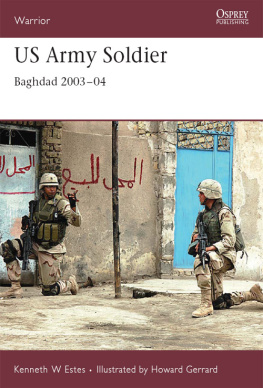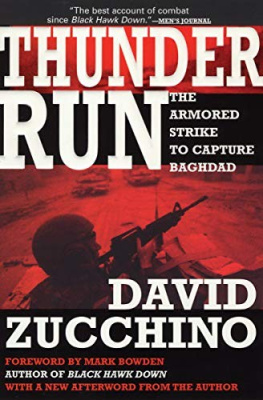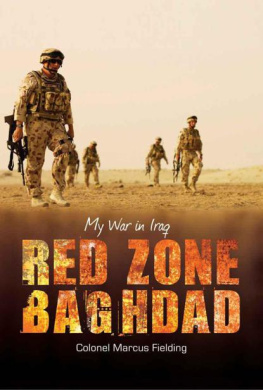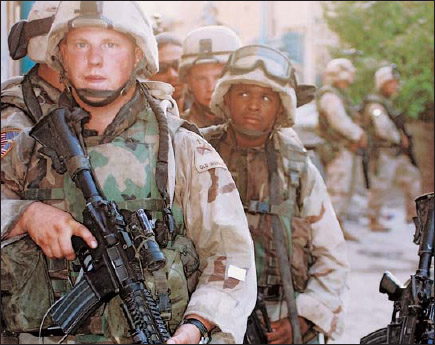Warrior 113
US Army Soldier
Baghdad 200304
Kenneth W Estes Illustrated by Howard Gerrard
CONTENTS
US ARMY SOLDIER: BAGHDAD 200304
INTRODUCTION
O n May 12, 2003, the 1st Battalion, 13th Armor (1/13th) convoyed to Baghdad, where it attached to the 3d Infantry Division for occupation duty. Even though the 1/13ths tanks and armored convoys entered the city after the US Presidents declaration that all major combat operations had ended, the tracers illuminating the night sky and rumbles of explosions in the distance gave a very different impression to the soldiers. The 1/13th Armor joined its parent 3d Brigade, 1st Armored Division (3d/1st) as the Bulldog brigade settled into its Baghdad zone as the first of the armored divisions major units to initiate Phase IVB (post-hostility) operations there.
The deployment of the 1st Armored Division (Old Ironsides) and its reinforcing units to the capital city of Iraq in 200304 contains many surprising turns of event. Originally slated for the opening invasion, the armored division instead became the senior organization responsible for Baghdads occupation. Situations did not always appear well oriented and often it required the tenacious efforts, skills, courage, and stamina of Iron Soldiers and their comrades to reach the desired outcome. The combat record of Old Ironsides in Iraq brings great credit upon the US Army and the armed forces of the United States of America. It lies interspersed with a seemingly endless range of tasks undertaken by the division and the task force it led, as it engaged in security and stabilization operations in Baghdad and the surrounding provinces.
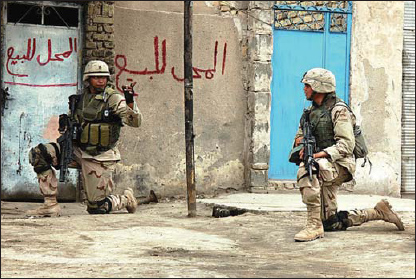
During a cordon and search operation, this staff sergeant (left) gestures to his section, off camera, to move to the flank. Remaining close by is his automatic rifleman, armed with the M249 Squad Automatic Weapon (SAW). Both men wear Interceptor vests with Small Arms Protective Inserts (SAPI), but other equipment varies. The helmet scope mount on the SAW-man is the screw-on type, and the SSG has an M-203 40mm grenade launcher, 4scope and AN/PEQ-2 laser pointer attached to his M4 carbine, for which he also wears the 40mm ammunition vest. The All-purpose Lightweight Individual Carrying Equipment (ALICE)-type magazine and grenade pouches are attached directly to the Interceptor vests, instead of using web gear, thus minimizing bulk and possible snags. Both wear kneepads; the leader is also wearing a leg strap clipboard on his right thigh and a transceiver on a carabineer clip.
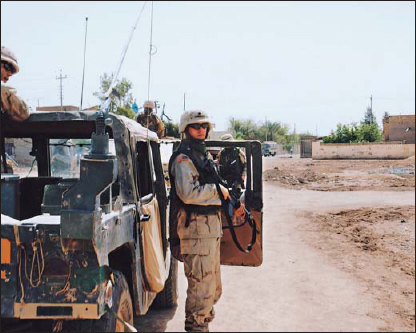
So scarce were the Up-Armored HMMWVs (UAHs) that soldiers naturally began to improvise add-on protection, often as simple as hanging bags containing Kevlar plates salvaged from vests and vehicles on the exterior of the otherwise thinly covered Humvee doors.
Nation building has existed as a military mission for the US Army throughout its history. In contemporary usage, it has sent chills through the ranks of politicos, pundits, and observers, and not a few serving military leaders. Nevertheless, most of the activities of the division fell within the main descriptions of nation building in its classic sense. The restoration of order in the capital, humanitarian assistance, training of security forces, and the facilitating of local government initially formed the bedrock of US and coalition actions in Baghdad. In addition, the concerted efforts by Task Force (TF) 1st Armored Division to repair and reconstruct the city infrastructure far exceeded the war damage sustained in the US occupation of Iraq in MarchApril 2003. In reality, the US forces began a long process of helping the local people to recover from the lengthy deprivation suffered under Saddam Husseins dictatorial regime.
The emerging evidence of the 200304 campaign by the TF 1st Armored Division and other elements of the US Central Command (USCENTCOM) will be debated by army institutions for decades to come. Few examples exist in US history of the extremes in operational employment experienced by the task force. War in Iraq was foreseen and planned for over a year by the division, which prepared for a decisive role in V Corps planning for the attack and seizure of the country. Despite this preparation for sustained high-intensity combat, only elements of its 3d Brigade would participate in the initial campaign. The deployment of the division from its posts in Germany brought it to the gates of Baghdad just in time for it to take the reins of authority for a mission not yet clear.
The military occupation of Baghdad called for the utmost of patience, perseverance, and fortitude, among many other requirements. The city was damaged, its inhabitants demoralized, and little vestige of civil authority remained. Hopes remained high, however, that the occupation would prove limited or even unnecessary and that the Iraqis would pick themselves up and begin a rebuilding process in the light of newly gained freedom. But as the 1st Armored Division took up its new and unplanned responsibilities, various forms of insurgency began to emerge and present increasing security threats to its soldiers and the citizens. For the division, nation building and combat operations would proceed in tandem, if not simultaneously, for almost all of its service in Iraq.
The most extraordinary set of circumstances Old Ironsides experienced lay a year ahead. As the summer of 2004 approached, with the divisions mission virtually accomplished and the turnover of its responsibilities for the city at hand, a new threat presented itself. A fresh uprising cut off land communications south of Kuwait, over which division units were even then convoying as the planned redeployment began. Baghdad and other cities erupted with new violence and armed insurrection came into the open as never before. Instead of returning to home posts, the 1st Armored Division and 2d Armored Cavalry Regiment (2d ACR) had to stop their redeployment in full stride, recover to a fully combat-ready stance, and prosecute a new and violent campaign against enemies in unfamiliar parts of Iraq. The epic Extension Campaign (Operation Iron Sabre) will long remain as one of the most novel military operations ever undertaken by an army division. It only capped, however, the extraordinary performance of Old Ironsides that itself remains a testimony to the professionalism and preparedness of the US Army in the beginning of the 21st century.
CHRONOLOGY
2001
November V Corps receives Joint Chiefs of Staff order to begin active planning for operations in southwest Asia, using a five-division base.
2002
July V Corps completes Operation Plan (OPLAN) Decisive Victory, its first plan involving 1st Armored Division and the first involving an attack all the way to Baghdad.
2003
February 7 1st Armored Division is dropped out of the initial deployment and assault plan for Operation

